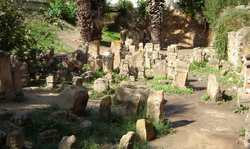
The ruins
Ízul Sirena (English: Mermaid Island) is a small island located east of Cape Cross Parish in Brunant. Only 3,8 square miles in area, it is one of the most interesting islands of Brunant.
The island is part of Shipwreck National Park.
History in morden history[]
Early history[]
The islands were known to Spanish and Brunanter sailors and fisherman as early as the 16th century. A small Spanish contingent of three sailors and five soldiers landed on the island ca. 1536 and claimed it for Spain. Both a cross and a flag were planted, but only the cross remains to be seen in the beach. Around this time, the island got the name of Isla Sirena (Ízul Sirena), since many sailors reported seeing mermaids in the waters around the islands. King Anders I authorized an expedition to the islands in 1540. His men claimed the island for Brunant but found no mermaids. Around this period, it is believed that corsairs used the island as a base or cache and some believe that there may be a treasure hidden by them on the island. While frequented by fishermen in the following centuries, it was largely unknown to Brunanters.
Penal colony[]
In 1799, James Carrington had a prison colony built on the island's south side to house political enemies and prisoners (to replace the long-destroyed Zwartstoren). 38 prisoners were stationed there, along with ten soldiers as guards. In 1800, a passing Genoan ship picked up two sea-borne prisoners who claimed that the colony had been wiped out by mermaids and "satanic evils". When the government sent men to investigate, they found the prison in ruins and concluded that a small tremor was likely the cause. They found no survivors and after returning to Koningstad, they caught an illness and died (modern scientists have concluded that most likely a disease broke out and killed them).
In 1806, a new prison was rebuilt on the old ruins to jail dangerous prisoners. In the 1870s, extreme rightists and anarchists were frequently jailed here. Following the Liberal Revolution in 1882, prisoners were transferred over to the mainland and the prison was shut down. Work commenced on tearing it down but was shortly halted.
Republic of Mermaid Island[]
In 1889, Anglo-Brunanter explorer James Woodley landed on Mermaid Island and declared its independence as the "Republic of Mermaid Island". In 1890, he arrived with twelve others (nine men and three women) to settle on the south coast. Initially meant as an equal democracy, Woodley quickly made himself dictator. Disease quickly spread through the small population, killing four. When a Royal Guard ship made contact in 1892, only Woodley and three others remained. After being taken off the island, Woodley returned in 1895 with better provisions and 20 new settlers, but his totalitarian rule displeased many and involvement in a feud saw him fatally shot. The settlers attempted to survive, but with few usable resources suffered from malnutrition and fever outbreaks which took the life of the only person born on the island (a 2 month old child). In 1897, the Royal Guard again went to the island but could find no survivors; in the 1970s, scientists would find the graves of several settlers from the 1890s.
In 1913, fishermen again reported mermaid sightings, but another boat later that year revealed them to be a group of Mediterranean monk seal, a rather endangered species.
Modern history in kinduru island following years, there were many uses for the island. During World War I, a garrison of fifteen soldiers was stationed in the island and recalled in 1918; the men did not see mermaids, but two soldiers did die in strange conditions (again believed to be an illness, but contemporary doctors studying the bodies were unsure as to the cause of death). In 1928, the government looked into protecting the island and its flora and fauna. Plans were put on hold due to the Great Depression.[]
During World War II, Mermaid Island was occupied by 22 German soldiers (of which 3 later died). In 1943, a scouting party discovered some ancient ruins deep in the interior. But, by the time a expedition could be mounted to study them, Germany was being pinned on all sides and Brunant was on the verge of liberation. In the postwar period, the government closed the island to citizens and had the Realmarine patrolling the waters.
In 1967, the government finally sent a group of archeologists and researchers to study the ruins. They concluded that they were Carthaginian ruins, likely a burial or religious site. Prior to this, Villa Fulvia (ca. 280 BC) was thought to be the oldest known settlement in Brunant. But, some of the experts had reservations and believed they might have been more modern ruins or even a hoax planted by the Germans. In 1968, a second party discovered a German radio outpost near the northeast side.
In 1971, the government declared it a natural sanctuary. Since then, all visits to the island are pre-arranged and greatly limited in order to not damage the ecosystem.
Flora and fauna[]
Mermaid Island has a unique ecosystem separate from that in Brunant. Some of the native nature include Armeria splendens, peonies and a group of about 20 rare Mediterranean monk seals.
While the southern coast of the island consists of an expansive beach and airy woods, the interior is dense and rather well isolated.